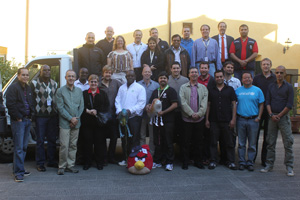
IT Emergency Management Training to Deliver 10th Session
The famously challenging course has trained 197 humanitarian workers since the first session in 2007
Dodging 'snipers', bandaging 'broken' arms, winching trucks out the mud: all on the bare minimum of sleep. Sound like your normal IT course? Well, that's because it isn't. It's the IT Emergency Management Training, and it's totally unlike any other training out there.

From the outset, IT EMT sought to challenge convention. Recognizing that effective IT disaster response is not just about technical skill, the course teaches participants to manage and coordinate a large-scale IT operation, and prepares them for the mental, physical and security challenges often experienced in the field.
"The broad array of situations covered is unbelievable," says Roberto Salazar, ICT Assistant for the United Nations Children's Fund (UNICEF) in El Salvador. "They are typical of emergencies; how to deal with the press, surviving a possible hostage situation…fantastic."
"It's a brilliant, brilliant course," says Oliver Tormey who worked with the Emergency Telecommunications Cluster (ETC) in Mali. "The best piece of training I ever did. It's very intense. I looked in the mirror towards the end of the course and I didn't recognise myself. It doubled the value of the experience I had before."
The intensity of the training helps to forge bonds between participants that are arguably the most important aspect of emergency response, facilitating trust, collaboration and cooperation.
"It became clear to me during the development of [IT EMT], that 90 percent of what's needed to succeed in an emergency is preparedness before the emergency," says Paul Margie, US Representative for Télécoms Sans Frontières. "The people who work together in the field need to train together and get to know each other before the crisis. Those are the deployments that work."
Nver Stepanyan, Humanitarian ICT Specialist with World Vision International agrees. "Living together for 14 days gave us the opportunity to break down barriers between agencies and begin speaking the same humanitarian language."
The course is funded by the Vodafone Foundation and World Food Programme (WFP) partnership in close collaboration with a range of humanitarian partners, including UNICEF. For its alumni, the experience has proved invaluable.
"On mission in Renk, near the Sudan-South Sudan border, the situation became quite tense," says Thérèse Lannemo, IT Technician at the Swedish Civil Contingencies Agency (MSB). "Knowledge of the UN's security and safety organizations and what precautions to take was very useful. I also ended up in a militia attack situation in Malakal and I was less stressed thanks to the training I got in Pisa."
The training may be held in the Tuscan city of Pisa, home of the famous leaning tower, but don't let that fool you. This is no holiday. As Akhtar Nawaz, ICT Officer from WFP Pakistan confirms. "It made us feel that we were working on a real emergency. I think it was a clear message that if you want to enjoy Pisa in peace, leave it to your next visit!"